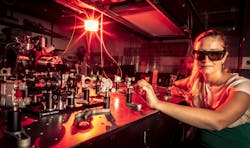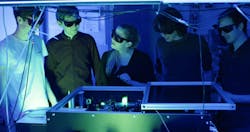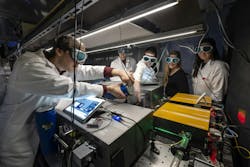Broadband UV dual-comb spectrometer measures pollutants in real time
A team of researchers led by Professor Birgitta Bernhardt at the Graz University of Technology (TU Graz) Institute of Experimental Physics in Austria recently developed what’s believed to be the world’s first broadband ultraviolet (UV) dual-comb spectrometer to detect and measure air pollutants—in real time (see video).
The inspiration comes from doing extreme ultraviolet (XUV) transient absorption studies during Bernhardt’s postdoctoral work that were limited by the spectral resolution of grating spectrometers. They tend to have a relative resolution of 10-3, which is insufficient to study light-induced electron dynamics on top of long-lived excitations like higher-lying Rydberg states.
“Originally coming from the field of frequency comb spectroscopy, a much higher spectral resolution was standard to me—at least 10-7 or better,” Bernhardt explains. “The next logical step was to combine broadband frequency-comb-based spectroscopy with absorption studies within the XUV.”
Taking dual-comb spectroscopy to XUV
Among broadband techniques, dual-comb spectroscopy is well established within the infrared spectral region. The method combines broad spectral coverage, short acquisition times, and high spectral resolution—three properties in mutual competition in traditional experiments. Transposing these features to the XUV meant an intriguing step for XUV absorption spectroscopy.
“Building the first broadband near-ultraviolet (NUV) dual-comb spectrometer is now our milestone toward this important development,” says Bernhardt.
The team’s spectrometer is based on the Fourier transform spectroscopy principle and is achieved by two optical frequency combs with slightly detuned repetition rates superimposed onto a photodiode for interference. The repetition rate detuning replaces the scanning-mirror of traditional Fourier transform spectrometers, which makes the measurement times one million times shorter.
As a result, a dual-comb spectrometer is akin to a ruler within the frequency domain—its fine-scale marks equidistant frequencies like the millimeter ticks of a conventional ruler. To achieve it, the spectrometer involves a special laser source that emits pulses pairs comprising simultaneously different wavelengths of a broad range. When this light penetrates a gaseous material sample its molecules absorb it, depending on the material’s properties.
During the absorption, the laser light pulses excite the sample gas molecules to rotate and vibrate. The resulting altered amplitudes of the laser spectrum—the transmission spectrum that’s characteristic to the involved molecules—reveal the sample’s composition and optical properties.
To transfer the concept to the UV, “the fundamental infrared (IR) radiation of the frequency combs must be upconverted into the UV range, which in our case is achieved via third harmonic generation,” Bernhardt says. “Broad spectral coverage within the UV range could be reached with—to the best of our knowledge—a new concept of nonlinear spectral broadening directly in a silicon fiber.”
The front end of the team’s spectrometer features two Yb-fiber-based frequency combs and “their outputs are amplified with a pulse-picking chirped-pulse amplifier, which is subsequently upconverted into the near-ultraviolet via third-harmonic generation,” says Bernhardt.
Its two UV pulse trains are then “superimposed and jointly interact with a gas sample—in our case, formaldehyde,” Bernhardt adds. “An ultrafast photodiode detects the transmission signal in the time domain and the transmission spectrum is subsequently retrieved after Fourier transformation.”
The team’s spectrometer combines several favorable features for spectroscopic investigations: broad spectral coverage, short acquisition times, and high spectral resolution.
Because it works within the UV, the spectrometer catches electronic, vibrational, and rotational excitations with a single measurement—so it can be used to explore diverse light-induced processes such as photodissociation involved in many reaction pathways of our atmospheric compounds. It can also detect trace gases because UV absorption cross sections of all elements are generally quite high.
“It was extremely satisfying to realize that our assumption of single interferogram retrieval was possible due to the large absorption cross sections within the UV range,” says Bernhardt. “This allows us to prove our spectrometer’s capability of real-time monitoring gas concentration changes for a variety of gas samples highly relevant to Earth’s environment. We could track the change of the formaldehyde concentration in our experimental chamber with a temporal resolution of 1 second—typically more than sufficient to monitor gas concentration changes within our atmosphere.”
Environmental monitoring
The most immediate application for the team’s spectrometer is environmental monitoring. They’ve already shown it can detect formaldehyde, which is an air pollutant produced from adhesives used for furniture or during the incineration of fossil fuels or wood.
“Our spectrometer could be used to protect both personnel and the environment because it can track formaldehyde emissions within the textile or wood processing industries, or cities with increased smog levels, in real time,” says Bernhardt.
It can also “be used to track other air pollutants such as nitrogen oxides, ozone, and other climate-relevant trace gases,” Bernhardt says. “We hope this will provide new findings about these gases’ effects in the atmosphere. Based on this, new strategies for improving air quality can be derived.”
What’s the next step? “With our first ‘single shot’ measurements, we ‘only’ achieved an improved resolution of one order of magnitude when compared to XUV grating spectrometers,” says Bernhardt. “But once we improve the stability of the lasers via phase stabilization, the spectral resolution could be further improved to about 10-8.”
FURTHER READING
L. Fürst et al., Optica, 11, 471–477 (2024); https://doi.org/10.1364/optica.516783.
About the Author
Sally Cole Johnson
Editor in Chief
Sally Cole Johnson, Laser Focus World’s editor in chief, is a science and technology journalist who specializes in physics and semiconductors.



